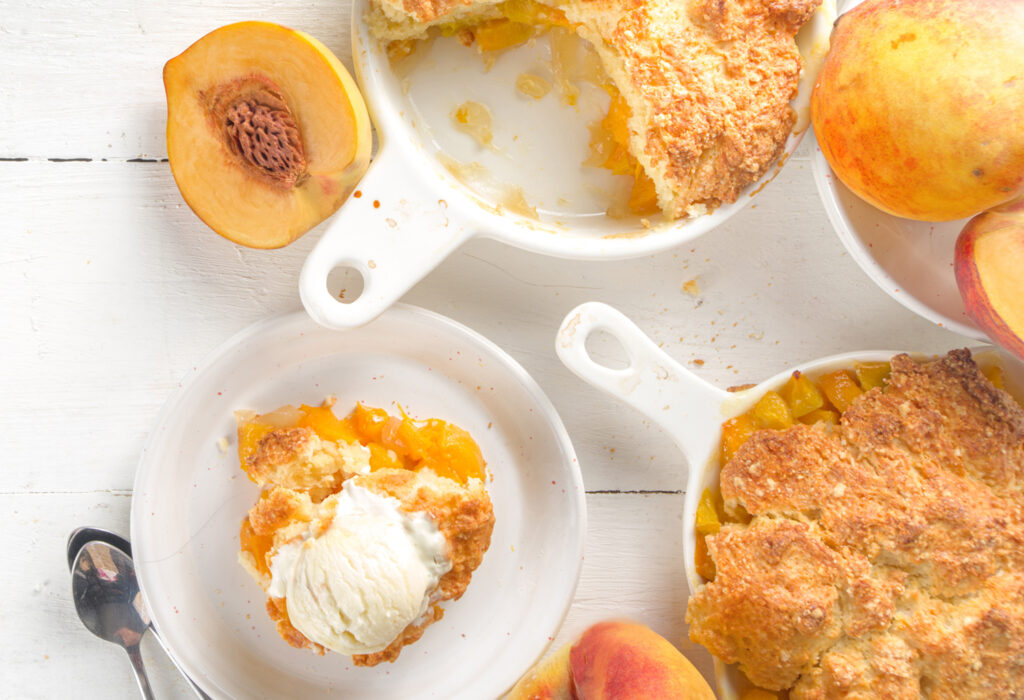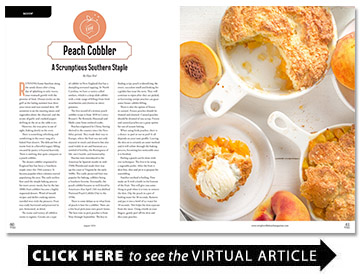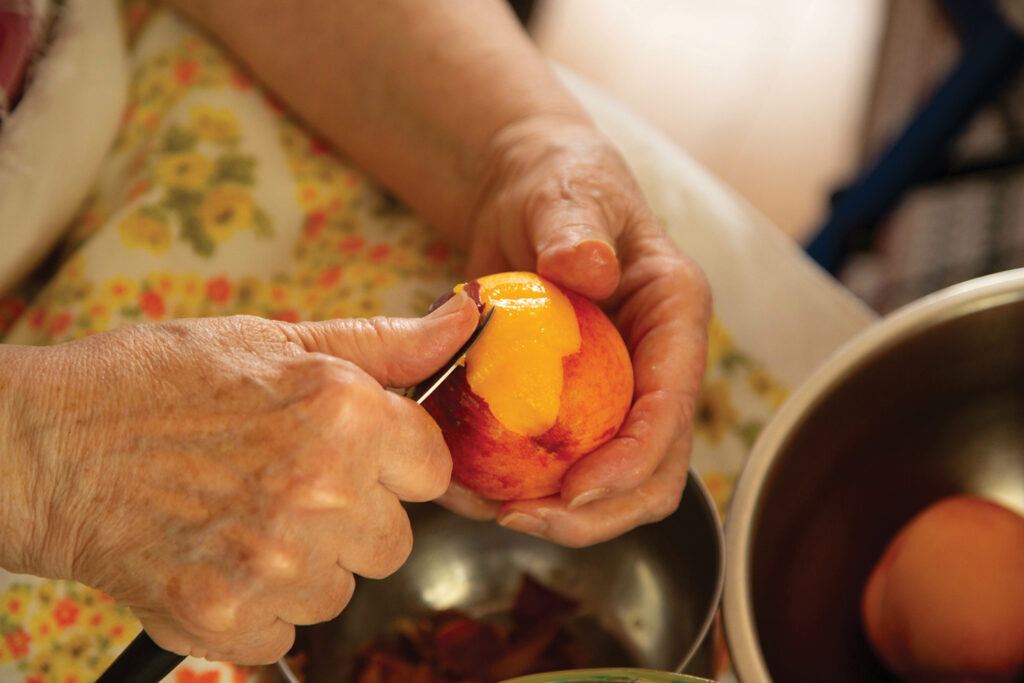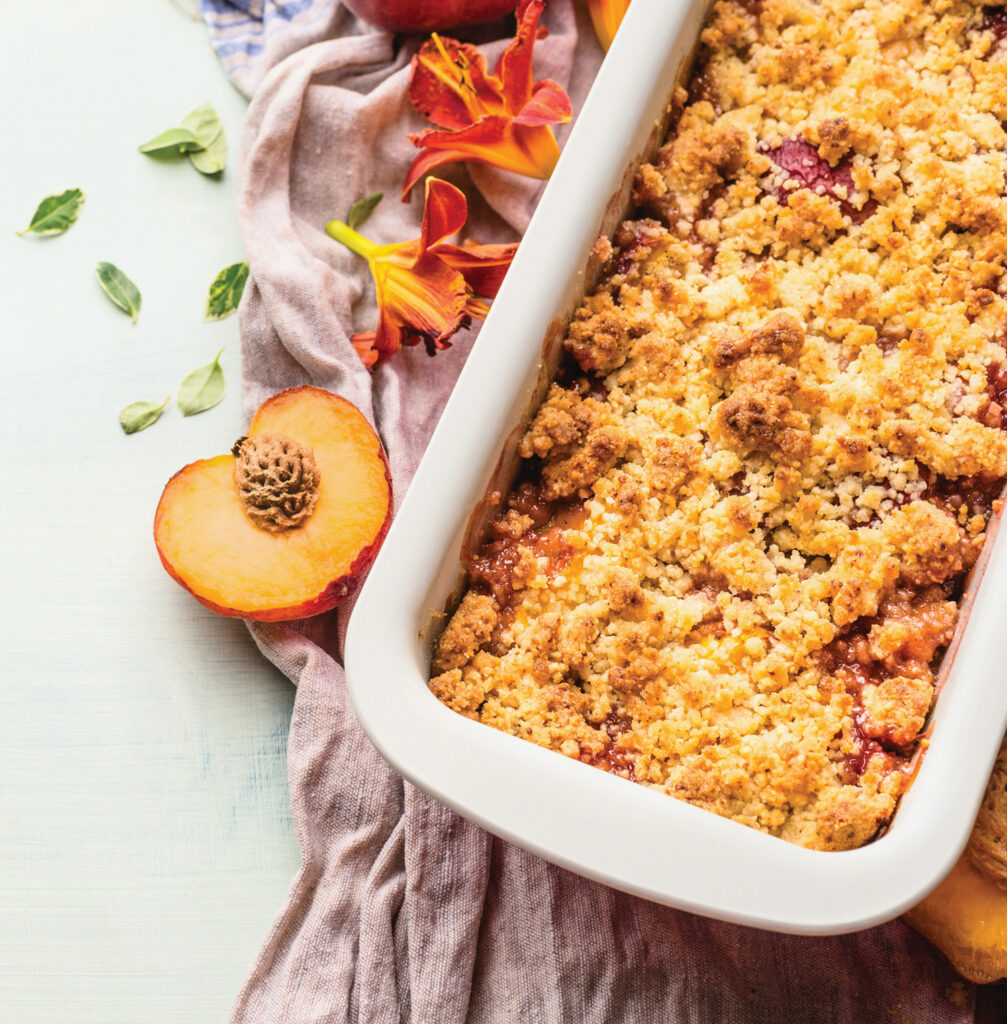
Running home barefoot along the sandy dunes after a long day of splashing in salty waves, your stomach growls with the promise of food. Dinner sizzles on the grill as the fading summer heat dries your sweat-and-sun-stained skin. All attention is on the roasting meats and vegetables above the charcoal, and the scents of garlic and cracked pepper drifting in the air as the table is set.
However, the true prize is out of sight, baking slowly in the oven.
There is something refreshing and comforting in the sweet tang of a baked fruit dessert. The delicate bite of warm fruit in a flavorful sugary filling encased by pastry is beyond heavenly. There is nothing that quite compares to a peach cobbler.
The dessert cobbler originated in England but has been a Southern staple since the 19th century. It became popular when colonists started populating the area. The early settlers first used the simple baking process for more savory meals, but by the late 1800s fruit cobblers became a highly requested dessert. Word-of-mouth recipes and skillet cooking talents traveled west with the pioneers. Fruit was easily harvested and preserved in jars, fermented, or dried.
The name and variety of cobblers varies in regions. Grunts are a type of cobbler in New England that has a dumpling-textured topping. In North Carolina, we have a variety called sonkers, which is a deep-dish cobbler with a wide range of fillings from fresh strawberries and cherries to sweet potatoes.
The first record of a written peach cobbler recipe is from 1839 in Lettice Bryant’s The Kentucky Housewife and likely came from enslaved cooks.
Peaches originated in China, having thrived in the country since the Neo-lithic period. They made their way to Europe, where the fruit was not only enjoyed in meals and desserts but also used widely in art and literature as a symbol of fertility, the fleetingness of life, one’s health, and immortality.
Peaches were introduced to the Americas by Spanish monks in mid-1500s Florida and made their way up the coast to Virginia by the early 1600s. The easily preserved fruit was popular for baking, cobblers being a Southern favorite. Eventually, the peach cobbler became so well-loved by Americans that April 13th was dubbed National Peach Cobbler Day in the 1950s.
There is some debate as to what form of peach is best for a cobbler. There are a few local pick-your-own peach farms. The best time to pick peaches is from May through September. The key to finding a ripe peach is identifying the sweet, succulent smell and looking for a golden hue near the stem. They will continue to ripen after they are picked, so harvesting unripe peaches can guarantee future cobbler filling.
There is also the option of frozen or canned. Frozen peaches should be thawed and drained. Canned peaches should be drained of any syrup. Frozen and canned peaches are a great option for out-of-season baking.
When using fresh peaches, there is a choice: to peel or not to peel? It all depends on your taste profile. Leaving the skin on is certainly an easier method and it will soften through the baking process, becoming less noticeable once it is finished.
Peeling a peach can be done with two techniques. The first is by using a vegetable peeler. After the fruit is skin-free, slice and pit it to prepare for assembling.
Another method is boiling. First make an X with a knife in the bottom of the fruit. This will give you something to grab when it is time to remove the skin. Dip the peach in a pot of boiling water for 30 seconds. Remove and put it into a bowl of ice water for 10 seconds. This helps the skin separate from the meat. Using a knife or your fingers, gently peel off the skin and slice your peaches.
Depending on the size of your baking pan and your desired fruit-to-crust ratio, you will need five to eight peeled, pitted, and sliced peaches. While pioneers used Dutch ovens and an open flame, we now have baking pans and ovens that ensure the dish is baked evenly and thoroughly.
Most recipes call for a combination of spices such as cinnamon and nutmeg, as well as various types of sugar. Other dry ingredients include flour, salt, corn starch, and baking powder to make the dough.
Whatever choices you make for your peach cobbler, this Southern masterpiece will be sure to satisfy.
As dinner is devoured, a sweet and soulful smell wafts out the open windows to the sensitive noses surrounding the table. Excitement and anticipation fill the hearts of the family and they start to mentally make room for a good-sized helping of warm peach cobbler, with maybe even a scoop of vanilla-bean ice cream to top it all off.
Peach Cobbler Recipe
Ingredients
Filling
- 5 peaches peeled (optional), pitted, and thinly sliced into wedges. (To easily peel fresh peaches, dunk them in boiling water, and then immediately into in an ice water bath. The skin will easily pull off without the use of a knife.)
- ¼ cup granulated white sugar
- ¼ cup brown sugar
- ¼ tsp cinnamon
- ⅛ tsp ground nutmeg
- ¼ Tbsp salt
- 1 tsp lemon juice
- 2 tsp cornstarch
Batter
- 6 Tbsp chilled and sliced butter
- 1 cup all-purpose flour
- 2 tsp baking powder
- ¾ cup milk
- ¼ cup granulated white sugar
- ¼ cup brown sugar
- 1 tsp ground cinnamon
- ¼ tsp salt
Instructions
Add sliced peaches, sugars, spices, lemon juice and cornstarch to a large non-stick pan over medium heat. Allow the sugars to melt and bring the juices out of the peaches, stirring constantly for 3 to 5 minutes, then remove from heat and set aside.
In a large bowl, mix the flour, sugar, cinnamon, baking powder, and salt. Work in the chilled butter using your fingers, a fork, or pastry blender. Add the milk and stir until combined.
Place the peaches in a buttered 9×13 baking pan and spread them evenly. Spoon the batter on top. Optional: add an extra coating of white sugar and cinnamon for more flavor.
Bake at 350 for 30-40 minutes until the crust is golden. Serve warm with an optional topping of vanilla ice cream.


